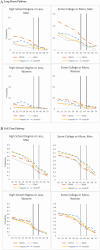The Uneven Later Work Course: Intersectional Gender, Age, Race, and Class Disparities
- PMID: 33687059
- PMCID: PMC8755889
- DOI: 10.1093/geronb/gbab039
The Uneven Later Work Course: Intersectional Gender, Age, Race, and Class Disparities
Abstract
Objectives: Later adult work attachments and exits are in flux, suggesting the need for understanding both the range of contemporary population-level pathways of work and nonwork and variations by overlapping social locations. We document patterned continuity and change in monthly work attachments and analyze the intersecting effects of age, gender, education, and race/ethnicity.
Methods: We capitalize on massive microlevel 16-month panel data from the Current Population Survey from 2008 through 2016 to empirically identify patterned pathways of monthly states: working full-time, long hours, part-time; being self-employed or unemployed; not working because of a disability, due to family care or other reasons, or because one defines oneself as retired.
Results: Analyses of 346,488 American women and men aged 50-75 years reveal patterned elasticity in the timing and nature of work attachments in the form of six distinctive pathways. Our intersectional analyses illustrate divergences and disparities: advantages for educated White men, disadvantages for low-educated Black men and women through their early 60s, and intersecting effects of gender, education, and race/ethnicity during the later work course across age groups. We find convergence across social markers by the 70s.
Discussion: This research highlights the importance of intersectional analysis, recasting the gendered work course in later adulthood into a framework of even greater complexities within mutually shaping categories of race/ethnicity, class, and age. Older Americans experience patterned, uneven pathways around work and nonwork. We recommend additional scholarship on the dynamics of constrained and disparate choices unfolding across multiple intersecting social locations.
Keywords: Class; Employment; Gendered life course; Intersectionality; Race/ethnicity.
© The Author(s) 2021. Published by Oxford University Press on behalf of The Gerontological Society of America. All rights reserved. For permissions, please e-mail: journals.permissions@oup.com.
Figures



Similar articles
-
Race/Ethnicity, Nativity, and Gender Disparities in Mental Health Trajectories from Mid- to Later-Life: A Life Course-Intersectional Approach.J Racial Ethn Health Disparities. 2024 Dec;11(6):3544-3560. doi: 10.1007/s40615-023-01808-x. Epub 2023 Sep 27. J Racial Ethn Health Disparities. 2024. PMID: 37755686
-
How Education Shapes Women's Work and Family Lives Across Race and Ethnicity.Demography. 2023 Aug 1;60(4):1207-1233. doi: 10.1215/00703370-10878053. Demography. 2023. PMID: 37470806 Free PMC article.
-
Disparate Disruptions: Intersectional COVID-19 Employment Effects by Age, Gender, Education, and Race/Ethnicity.Work Aging Retire. 2020 Oct;6(4):207-228. doi: 10.1093/workar/waaa013. Epub 2020 Sep 12. Work Aging Retire. 2020. PMID: 33214905 Free PMC article.
-
Systematic review and meta-analysis of patient race/ethnicity, socioeconomics, and quality for adult type 2 diabetes.Health Serv Res. 2020 Oct;55(5):741-772. doi: 10.1111/1475-6773.13326. Epub 2020 Jul 27. Health Serv Res. 2020. PMID: 32720345 Free PMC article.
-
Differential environmental exposure among non-Indigenous Canadians as a function of sex/gender and race/ethnicity variables: a scoping review.Can J Public Health. 2014 Nov 21;105(6):e438-44. doi: 10.17269/cjph.105.4265. Can J Public Health. 2014. PMID: 25560890 Free PMC article.
References
-
- Abbott, A., & Tsay, A. (2000). Sequence analysis and optimal matching methods in sociology. Sociological Methods & Research, 29(1), 3–33. doi:10.1177/0049124100029001001 - DOI
-
- Cahill, K. E., Giandrea, M. D., & Quinn, J. F. (2015). Retirement patterns and the macroeconomy, 1992–2010: The prevalence and determinants of bridge jobs, phased retirement, and reentry among three recent cohorts of older Americans. The Gerontologist, 55(3), 384–403. doi:10.1093/geront/gnt146 - DOI - PubMed
-
- Cahill, K. E., Giandrea, M. D., & Quinn, J. F. (2016). Evolving patterns of work and retirement. In George L. K. & Ferraro K. F. (Eds.), Handbook of aging and the social sciences (pp. 271–291). Elsevier/Academic Press. doi:10.1016/b978-0-12-417235-7.00013-5 - DOI
Publication types
MeSH terms
Grants and funding
LinkOut - more resources
Full Text Sources
Other Literature Sources
Medical

